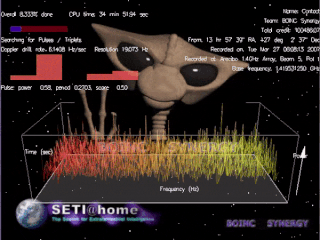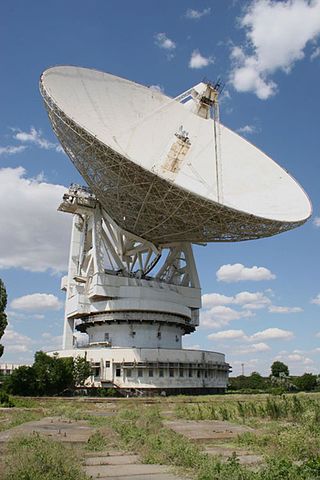
The Drake equation is a probabilistic argument used to estimate the number of active, communicative extraterrestrial civilizations in the Milky Way Galaxy.

The search for extraterrestrial intelligence (SETI) is a collective term for scientific searches for intelligent extraterrestrial life, for example, monitoring electromagnetic radiation for signs of transmissions from civilizations on other planets.

Frank Donald Drake was an American astrophysicist and astrobiologist.
Extraterrestrial intelligence refers to hypothetical intelligent extraterrestrial life. No such life has ever been proven to exist in the Solar System except for humans on Earth, and its existence on other star systems is still speculative. The question of whether other inhabited worlds might exist has been debated since ancient times. The modern form of the concept emerged when the Copernican Revolution demonstrated that the Earth was a planet revolving around the Sun, and other planets were, conversely, other worlds. The question of whether other inhabited planets or moons exist was a natural consequence of this new understanding. It has become one of the most speculative questions in science and is a central theme of science fiction and popular culture.

SETI@home is a project of the Berkeley SETI Research Center to analyze radio signals with the aim of searching for signs of extraterrestrial intelligence. Until March 2020, it was run as an Internet-based public volunteer computing project that employed the BOINC software platform. It is hosted by the Space Sciences Laboratory at the University of California, Berkeley, and is one of many activities undertaken as part of the worldwide SETI effort.

Project Ozma was a search for extraterrestrial intelligence (SETI) experiment started in 1960 by Cornell University astronomer Frank Drake, at the National Radio Astronomy Observatory, Green Bank at Green Bank, West Virginia. The object of the experiment was to search for signs of life in distant planetary systems through interstellar radio waves. The program was named after Princess Ozma, ruler of the fictional land of Oz, inspired by L. Frank Baum's supposed communication with Oz by radio to learn of the events in the books taking place after The Emerald City of Oz. The search was publicized in articles in the popular media of the time, such as Time magazine and was described as the first modern SETI experiment.

The Wow! signal was a strong narrowband radio signal detected on August 15, 1977, by Ohio State University's Big Ear radio telescope in the United States, then used to support the search for extraterrestrial intelligence. The signal appeared to come from the direction of the constellation Sagittarius and bore the expected hallmarks of extraterrestrial origin.
The Arecibo message is an interstellar radio message carrying basic information about humanity and Earth that was sent to the globular cluster Messier 13 in 1974. It was meant as a demonstration of human technological achievement, rather than a real attempt to enter into a conversation with extraterrestrials.

The communication with extraterrestrial intelligence (CETI) is a branch of the search for extraterrestrial intelligence (SETI) that focuses on composing and deciphering interstellar messages that theoretically could be understood by another technological civilization. The best-known CETI experiment of its kind was the 1974 Arecibo message composed by Frank Drake.

The Teen Age Message (TAM) was a series of interstellar radio transmissions sent from the Yevpatoria Planetary Radar to six solar-type stars during August–September 2001. The structure of the TAM was suggested by Alexander Zaitsev, Chief Scientist at Russia's Institute of Radio-engineering and Electronics. The message's content and target stars were selected by a group of teens from four Russian cities, who collaborated in person and via the Internet. Each transmission comprised three sections: a sounding, a live theremin concert, and digital data including images and text. TAM was humanity's fourth Active SETI broadcast and the first musical interstellar radio message.

SETI@home beta, is a hibernating volunteer computing project using the Berkeley Open Infrastructure for Network Computing (BOINC) platform, as a test environment for future SETI@home projects:
SERENDIP is a Search for Extra-Terrestrial Intelligence (SETI) program originated by the Berkeley SETI Research Center at the University of California, Berkeley.

The Arecibo Telescope was a 305 m (1,000 ft) spherical reflector radio telescope built into a natural sinkhole at the Arecibo Observatory located near Arecibo, Puerto Rico. A cable-mount steerable receiver and several radar transmitters for emitting signals were mounted 150 m (492 ft) above the dish. Completed in November 1963, the Arecibo Telescope was the world's largest single-aperture telescope for 53 years, until it was surpassed in July 2016 by the Five-hundred-meter Aperture Spherical Telescope (FAST) in Guizhou, China.
Active SETI is the attempt to send messages to intelligent extraterrestrial life. Active SETI messages are predominantly sent in the form of radio signals. Physical messages like that of the Pioneer plaque may also be considered an active SETI message. Active SETI is also known as METI.

Cosmic Call was the name of two sets of interstellar radio messages that were sent from RT-70 in Yevpatoria, Ukraine in 1999 and 2003 to various nearby stars. The messages were designed with noise-resistant format and characters.

Lone Signal was a crowdfunded active SETI project designed to send interstellar messages from Earth to a possible extraterrestrial civilization. Founded by businessman Pierre Fabre and supported by several entrepreneurs, Lone Signal was based at the Jamesburg Earth Station in Carmel, California.

Breakthrough Listen is a project to search for intelligent extraterrestrial communications in the Universe. With $100 million in funding and thousands of hours of dedicated telescope time on state-of-the-art facilities, it is the most comprehensive search for alien communications to date. The project began in January 2016, and is expected to continue for 10 years. It is a component of Yuri Milner's Breakthrough Initiatives program. The science program for Breakthrough Listen is based at Berkeley SETI Research Center, located in the Astronomy Department at the University of California, Berkeley.

The Berkeley SETI Research Center (BSRC) conducts experiments searching for optical and electromagnetic transmissions from intelligent extraterrestrial civilizations. The center is based at the University of California, Berkeley.

The following outline is provided as an overview of and topical guide to extraterrestrial life:














